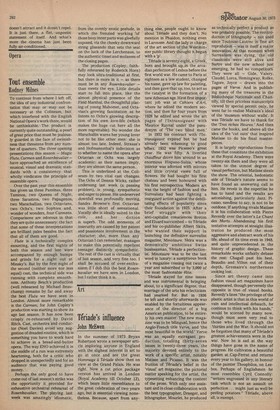Art
Teriade's influence
John McEwen
In the summer of 1973 Bryan Robertson wrote a newspaper article imploring anyone in England with the slighest interest in art to go at once and see the great Hornmage a Teriade show then on view at the Grand Palais. He was right. Now a cut price package version has arrived in London (Royal Academy till October 12), which bears little resemblance to the great celebration of two years ago, but is essential viewing nonetheless. Because, apart from any thing else, people ought to know about Teriade and they don't. No mention in Phaidon, nothing even in Larousse. And the lady in charge of the art section of the Westminster public library thought it began with a 'p'.
Teriade is seventy-eight, a Greek, born and brought up in the arcadian perfection of Lesbos before the first world war. He came to Paris at, eighteen as a law student, changed his name, gave up law for painting, and then gave that up, too, to act as the catalyst in the formation of a new Athenian age. Hirst first important job was at Cahiers d'Art, where he edited the modern section, and then for four years from 1928 he edited and wrote the art pages of l'Intransigeant with Maurice Raynal under the pseudonym of 'The two blind men.'
In 1932 his contract with /Intransigeant expired but he had already been scheming to good 'effect. 1932 was Picasso's great year. He was fifty. A liveried chauffeur drove him around in an enormous Hispano-Suiza, whose interior was adorned with mirrors and little crystal vases full of flowers. He had bought his first chateau and been honoured with his first retrospective. Modern art was the height of fashion and the Surrealists had been fighting a rearguard action against the debilitating effects of popularity since their foundation in 1925. After a. brief struggle with their' anti-capitalist consciences Breton and Eluard succumbed — to Teriade and his co-publisher Albert Skira, who wanted their support in launching the definitive surrealist magazine, Minotaure. Skira was a demonically ambitious Swiss businessman, Teriade a perfectionist. Minotaure was to be the last word in luxury: a sumptuous book of a magazine coming out twice a year and subscribed to by 3,000 of the most fashionable elite.
Teriade stayed for nine issues and was instrumental in bringing about, to a significant degree, that marriage of the arts his eclecticism had yearned for. But in 1936 he left and shortly afterwards was enabled by the fortuitious appearance of the director of a big American publication, to be entirely his own master. The new magazine was to be bilingual, hence the Anglo-French title Verve, and 'the most beautiful in the world.' Verve was an equally extragant pro duction, totalling thirty-seven issues in twenty-three years, the majority devoted entirely to the work of a specific artist, notably Matisse and Picasso. It was the fruition of Teriade's belief in the 'visual' art magazine: the pictorial matter speaking for the artist, the, typesetting enhancing the content of the prose. With only one assistant and in close collaboration with the best typographer, Draeger, and lithographer, Mourlet, he produced as technically perfect a product as was probably possible. The reintroduction of lithography — not used since Toulouse-Lautrec in fine art reprodution — was in itself a major innovation. At that moment when Surrealism was dying, the old classicists were still alive and Sartre and the new school just emerging, he had no competitors. They were all — Gide, Valery, Claudel, Lorca, Hemingway, Rolke, Tagore, Joyce — drawn into the pages of Verve. And in publishing many of the treasures in the Bibliotheque Nationale and Chantilly, till then priceless manuscripts viewed by special permit only, he went far to realise Malrattx's ideal of the 'museum without walls'. It was Teriade we have to thank for the 'Tres riches Heures And then came the books, and above all the idea of the 'cut outs' that inspired Matisse to do his final masterpieces.
It is largely reproductions from these that constitute the exhibition at the Royal Academy. There were twenty-six them and they were all taken to the utmost degree of visual perfection, but Matisse steals the show. The oriental, hedonistic side of Teriade's nature seems to have found an answering call in him. He revels in the expertise he has to hand and the results are astonishing, particularly Jazz. Picasso, needless to say, is not to be outdone. If anything rivals Matisse it is his collaboration with Pierre Reverdy over the latter's Le Chant des Morts. Abandoning his first tentative attempts at straight illustration he produced the most aggressive and abstract work of his life, ahead of its time even in 1948, and quite unprecedented in the history of graphic design. These remarkable works unfairly debase the rest: Chagall past his best, Beaudin and Vilion out of their depth, Gromaire's northerness looking lost.
Since art theory came into fashion visual art magazines have disappeared, though perversely the opposite is true of visual books. Reverdy's lines "the privilege of the plastic artist is that in this world of vain and intellectual debauch, he' continus to think with his hands,", would be scorned by many now, though must seem very real to those who lived through the 'thirties and the War. It should not be forgotten that many of Teriade's greatest achievements were in the war. Now he is sad at the way things have gone in the name of progress. He cultivates a beautiful garden at Cap-Ferrat and returns every year to his gallery, in honour of the painter Theophilos, on Lesbos. Perhaps of Englishmen he most resembles Cyril Connolly: "writers engrossed in any literary task which is not an assault on perfection ... might just as well be peeling potatoes." Teriade, above all, is exempt.


































 Previous page
Previous page